
Guests
- Kelly Posner Gerstenhaberprofessor of psychiatry at Columbia University and the founder and director of The Columbia Lighthouse Project.
The father of a 6-year-old girl who was killed in the 2012 mass shooting at Sandy Hook Elementary School was found dead by apparent suicide Monday. Jeremy Richman was a neuroscientist who, after the death of his daughter Avielle, founded the Avielle Foundation to support brain science research, with the ultimate goal of preventing violence and building compassion. The news of his death came just days after two students who survived last year’s shooting massacre at Marjory Stoneman Douglas High School in Parkland, Florida, died by suicide. An unnamed student died Saturday, according to local authorities, and 19-year-old Sydney Aiello died last weekend. Suicide is the 10th leading cause of death in the United States. We speak with Kelly Posner Gerstenhaber, professor of psychiatry at Columbia University, founder and director of The Columbia Lighthouse Project. If you or someone you know may be considering suicide, contact the National Suicide Prevention Lifeline at 1-800-273-8255.
Transcript
AMY GOODMAN: This is Democracy Now! I’m Amy Goodman, with Juan González.
JUAN GONZÁLEZ: We turn now to the public health crisis of suicide. The father of a 6-year-old girl who was killed in the 2012 mass shooting at Sandy Hook Elementary School was found dead by apparent suicide Monday. Jeremy Richman was a neuroscientist who, after the death of his daughter Avielle, devoted his life to finding solutions to brain abnormalities that lead to violence. He founded the Avielle Foundation to support brain science research, with the ultimate goal of preventing violence and building compassion. This is Jeremy Richman speaking in 2013.
JEREMY RICHMAN: We need to face and take action on hard issues. There is not going to be one simple solution. But we feel it is essential to get a deeper understanding of mental health, in terms of research, education and policy.
JUAN GONZÁLEZ: That was Jeremy Richman, the Sandy Hook father who took his own life yesterday. The news of his death came just days after two students who survived last year’s shooting massacre at Marjory Stoneman Douglas High School in Parkland, Florida, died by suicide. An unnamed student died Saturday, according to local authorities, and 19-year-old Sydney Aiello died last weekend. Aiello suffered from post-traumatic stress disorder and survivor’s guilt, according to her mother. Seventeen students, staff and teachers were killed in Parkland on February 14, 2018, in one of the deadliest school shootings in U.S. history.
AMY GOODMAN: David Hogg, a Parkland massacre survivor and gun control activist, tweeted Sunday, “How many more kids have to be taken from us as a result of suicide for the government / school district to do anything? Rip [rest in peace] 17+2.”
And this is Ryan Petty, whose daughter Alaina died in the Parkland shooting, speaking to CNN on Monday.
RYAN PETTY: I think parents are wanting answers. They’ve got a lot of questions. And they’re wondering, you know: Could this—could this be my son or daughter? And so, what we talked about yesterday in our emergency meeting was, we really need to drive awareness. We need to make sure that everyone in the community, especially parents, understand that their child may be at risk or their loved one may be at risk. And so, we wanted to drive that awareness, not to scare them or to create more concern, but to make sure that they understand what to look for. And then we wanted to equip those parents with the right questions to ask. So, we want to drive awareness but make sure they have the right questions and the knowledge to determine whether or not their child is at risk.
JUAN GONZÁLEZ: Suicide rates are continuing to rise in the United States. A report out last year by the Centers for Disease Control and Prevention found the U.S. suicide rate increased by 25 percent over the past two decades. Topping the list was North Dakota, where suicides rose by 57 percent from 1999 levels. Suicide is now the 10th leading cause of death in the United States. The report found that nearly 45,000 suicides occurred in the country in 2016, more than twice the number of homicides. Firearms accounted for 51 percent of all suicides in the same year. Among people aged 15 to 34, suicide was the second leading cause of death.
AMY GOODMAN: If you or someone you know may be considering suicide, contact the National Suicide Prevention Lifeline at 1-800-273-TALK. That’s 1-800-273-8255.
We’re joined right now by Dr. Kelly Posner Gerstenhaber. She’s a professor of psychiatry at Columbia University, founder and director of The Columbia Lighthouse Project. Last year, she worked on a suicide prevention event in Parkland. Her recent article for the Miami Herald headlined “To help prevent suicide, all we have to do is ask.”
Dr. Kelly Posner Gertenhaber, thanks so much for being with us. Can you first respond to what happened this weekend? Because you spent time in Parkland advising people after the massacre. You feared exactly this would happen.
KELLY POSNER GERSTENHABER: Well, let me start with the good news, because I think we all need a little bit of that. You know, suicide is preventable, and there is help out there for people suffering.
But you started to say how this is one of the world’s greatest public health crises. Let me just—let me reinforce that for a minute. You know, number one cause of death in adolescent girls across the globe, takes more lives than car accidents, more firemen than fire, more police than crime. And 135 people are affected for every death, and those effects linger across generations because of the silence that often follows.
And so, I said we can actually save these lives. What do we know we need to do? Did you know that 50 percent of suicides see their primary care doctor the month before they die? We need to be asking, the way we monitor for blood pressure. Many adolescents who show up to the emergency department, who have tried to take their own lives, are not there for psychiatric reasons.
But we know that even that’s not enough in terms of finding the people suffering in silence. You know, the under secretary wrote this urgent memo that we must go beyond the doctor’s office, with something called the Columbia Protocol, that Ryan Petty was talking about giving to every parent in the community. We need to find people where they live—teachers, coaches, peers—before they ever, if they ever, get to a doctor, so we can better identify the people who need help, and connect them to that care that they need.
Because you know what? When people are suffering, they actually want help. My colleague who survived jumping off the Golden Gate Bridge said people who are suicidal want to be saved. What we need is a culture where no one is afraid to ask, so we can find them and get them that help.
And what’s really empowering is that there are things we can do. And that’s what we started talking about last year, and that’s what Ryan Petty and Parkland have been talking about every day now. We need to equip the community. And these few simple questions are a way that everybody can be part of the solution.
AMY GOODMAN: Talk about what those questions are.
KELLY POSNER GERSTENHABER: Yeah. So, it’s a few simple questions that identifies suicidal thinking and suicidal behavior for the first time. And what does that mean? We used to just ask about a suicide attempt, and then you miss the person that bought the gun or wrote the note or collected the pills, things we absolutely cannot afford to miss. And it’s the first time we know the right questions to figure out whose thoughts actually indicate imminent risk.
And you know what? It also has a connection to prevention of gun violence, which is how I first got together with Parkland and many other communities. Did you know 90 percent of shooters have suicidal issues? So, if we ask a few questions, we might be able to find people who need help, before it’s too late. You know, early identification. So, these simple questions, to connect the right people to care, have many, many positive, positive outcomes.
JUAN GONZÁLEZ: And in your experience, given this exploding suicide rate in the country, especially among young people, what do you think is sparking or causing this? Is it a general, a growth—there’s been a growth of anxiety among young people especially. But your sense of what are the underlying causes of this increase?
KELLY POSNER GERSTENHABER: Well, let me be clear: It’s been a very slow and steady rise, about 1 percent a year over the last 30 years. Now, recently, it’s been, you know, slightly higher than that. But this has been a problem and, you know, a massive, massive problem.
You know, the biggest cause of suicide is a treatable medical illness called depression. But we don’t think of depression like we think of cancer. You wouldn’t hear the word “choice” when it comes to cancer. Did you know depression is the number one cause of global disability, costs humanity more than anything? And guess what. Because people don’t think of this like a medical illness—snap out of it, I’m weak if I ask for help—it prevents them from actually getting the life-saving medications and care and treatment that they need. So we very much have to break down barriers of stigma and misunderstanding, so we can identify people suffering in silence and connect them, connect them to the care they need. We know that not treating depression is actually what kills people.
AMY GOODMAN: And we’re going to get to those questions, what you ask someone—Does it have to be a professional asking? Can it be a friend asking?—in 30 seconds, because we’re going to break now. We’re speaking to Dr. Kelly Posner Gerstenhaber, professor of psychiatry at Columbia University, founder and director of The Columbia Lighthouse Project. Stay with us.
[break]
AMY GOODMAN: “Ramparts” by John Frusciante. This is Democracy Now!, democracynow.org, The War and Peace Report. I’m Amy Goodman, with Juan González. Our guest is Dr. Kelly Posner Gerstenhaber, professor of psychiatry at Columbia University.
Dr. Gerstenhaber, you are the principal author of the Columbia Protocol. What is it? What are the questions that need to be asked?
KELLY POSNER GERSTENHABER: So, these few simple questions, that can and should be in everybody’s hands, go as follows. It starts with: Have you wished you were dead or go to sleep and not wake up? Or have you actually had thoughts of killing yourself? And if that’s yes, have you thought about how you might do this? Have you had these thoughts and had some intention of acting on them, or have you started to work out or worked out the details of how to kill yourself? Do you intend to carry out this plan? And then, have you ever done anything, started to do anything or prepared to do anything to end your life, like collecting pills, writing a note, buying a gun? And we know if they say, “I had some intention to act on these thoughts,” that’s when risk goes up 50 percent, and we know somebody is at more imminent risk and needs help. Also, if they had any of those behaviors, things we were never, never asking about before.
JUAN GONZÁLEZ: But when do parents or loved ones—
KELLY POSNER GERSTENHABER: Yeah.
JUAN GONZÁLEZ: —or friends ask this question? Because, obviously, there’s a reluctance to even broach the subject.
KELLY POSNER GERSTENHABER: There is. And that’s what people need to understand. When people are suffering, they actually want to be asked. And in the past, friends or parents didn’t know what questions to ask. They didn’t know what to do with the answers. And they didn’t know if somebody wanted to be asked.
So, now we have the tools. Every set of these questions comes with the next steps. And the most important thing you can—when you think something’s just not right or somebody looks like they’re not themselves, ask the questions. Now, if you go into the primary care office, you’ll get it like blood pressure. But here, every family member, every community member, every loved one, every teacher can actually have a set of questions that they can use if they feel it would be helpful.
AMY GOODMAN: But so often, at a very difficult time, a person either goes into a shell, becomes less communicative, or the opposite—much more aggressive, alienating people. It seems to be the most difficult time to ask questions like these.
KELLY POSNER GERSTENHABER: Well, I think that that’s not what we find. You know, when people are suffering in silence and they’re feeling depressed, they actually want to be asked. And we often assume that they’re going to have the will to come to us. And they often don’t. That’s why we need to come to them. And again, when people are suffering, they want to feel better. They just don’t know that they can. So, it’s to connect them and identify that pain they’re going through. And very often, you know, depression actually does present like that—aggression, irritability. And it all can be a symptom of exactly the same thing. And again, the more we ask, the more we identify directly, identify suicidal feelings directly, the more we’re going to help people get the treatment they need to save their lives and reduce this terrible suffering. And the beautiful part of this, or one of the positive outcomes, is that now the community can be engaged in something positive and meaningful that can actually help save lives and prevent these terrible tragedies we’re dealing with, again, in the last few days.
JUAN GONZÁLEZ: I wanted to ask you. In the last couple of months, there were two Stanford University students who died by suicide. One of them was an athlete who had won a silver medal with her cycling team at the 2016 Olympic Games. Are there any particular groups of young people that might be subjected to more pressures that might get them to think of suicide—for instance, I’m thinking of athletes, in particular—that you’ve dealt with?
KELLY POSNER GERSTENHABER: Not really. This is—the biggest cause is this medical illness called depression, right? And it’s the second leading cause of death in 10-to-24-year-olds. But your point is an important one. You know, Princeton came to me: “First let’s give these questions to the athletic coaches, to the resident advisers.” So, the point is, everybody suffers and is at high risk for depression and for suicide. But how do we find them and connect them? So, putting these questions in the hands of the coach and the teacher and the peer is really, really important. This isn’t about, you know, pressure or being at a school where academic pressure is bad or is increased, or, you know, you’re an athlete and you have more pressure because of those demands. It’s really because of this—you know, the biggest cause, again, is this medical illness that we suffer from, and we need to identify people.
AMY GOODMAN: And what do you say to schools for how they should deal with this? Like, for example, Juan just mentioned the two Stanford students, one after the other, in the same division, in math and engineering, grad students, one in her dorm room, the other in his lab. What should schools do? And are kids afraid of coming forward—young people, students—that they might be thrown out of a school, because they don’t want to sully their reputation, the school wants to make sure someone like this doesn’t wreck their record?
KELLY POSNER GERSTENHABER: Yes, students are afraid to speak out and get help because of all of that stigma, where we don’t think of this like any other medical illness. What schools can do is screen as much as they can, arm people with the way to identify people. You know, college presidents worry much, very much, about the liability of suicide. You know, a history of a suicide attempt is the number one risk factor. When they come in for their health screens, ask a few questions. Find people who need ongoing monitoring, etc. When we start to treat this like any other illness, like asthma, you know, like blood pressure, etc., we will break down those barriers and get kids the help that they need.
JUAN GONZÁLEZ: And what about the situations, for instance, the two students from Parkland, those who survive mass shootings? There’s generally immediate grief counseling provided by the schools, but this now happens a year later. What kind of ongoing support is necessary for young people who survive mass shootings?
KELLY POSNER GERSTENHABER: Yeah, so, long-term outcomes for survivors of shootings are really improved with community connections and continuing access to mental health treatment, so—and empowering them particularly with student and community efforts. And in the short term, we know that medications help very much with anxiety reduction. And PTSD is a form of anxiety. We know that there are skills that can be given and, you know, mechanisms, in addition to medication, that will continue to reinforce thinking and writing and talking about the traumas that they’ve gone through.
AMY GOODMAN: Sydney Aiello’s mom, the 19-year-old young woman, survivor of the massacre, who just took her own life last weekend, she said she suffered from PTSD and from survivor’s guilt. What does that mean? And what did you find when you went to Parkland in talking to students and family members?
KELLY POSNER GERSTENHABER: Well, I originally went to Parkland to work with the community to help them start to figure out how to identify and put the Columbia Protocol in people’s hands. But what we know is that survival guilt has long been connected to PTSD, after lots of traumatic incidents, like Holocaust, combat survivors, you know, and we know that, again, when you add that on top of a baseline mental health issue like depression or anxiety, the risk just goes up even farther. And people don’t know how to deal with the distorted beliefs that they have from the PTSD—you know, perceived responsibility, they could have done something, etc. So, we really need to get at helping give them the tools to address the trauma that they’re dealing with, probably on top of other anxieties and depression after these terrible incidents.
JUAN GONZÁLEZ: And what is the medical community, in your view, not doing—and I would include in the medical community the insurance companies that have a lot to say over what kind of treatment people get—in terms of dealing with these mental health issues?
KELLY POSNER GERSTENHABER: I think one of the most important things that we’re dealing with as a society in the medical community, the biggest barrier to effective treatment is stigma. You know that since we have antidepressants, for example, the suicide rate has dropped dramatically across the world, across ages, reversing a trend prior to their introduction. However, 50 to 75 percent of people who need those medications do not get them, because of stigma and people not wanting to access treatment, because they don’t think of this like any other medical illness.
AMY GOODMAN: We’re going to ask you to stay with us, and we’re going to post online Part 2 of this discussion. We want to ask about veterans, also to talk to you about just every day in workplaces how things should be identified, when people don’t want to be, you know, telling on someone, ratting out someone, but deeply concerned about someone’s behavior and feelings. Dr. Kelly Posner Gerstenhaber, professor of psychiatry at Columbia University, founder and director of The Columbia Lighthouse Project.
If you or someone may be considering suicide, contact the National Suicide Prevention Lifeline at 1-800-273-TALK. I’m Amy Goodman, with Juan González.

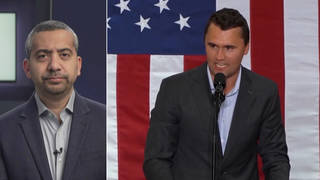
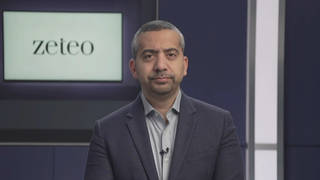
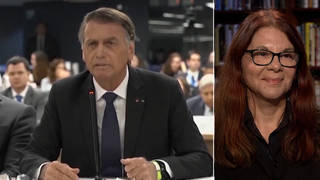
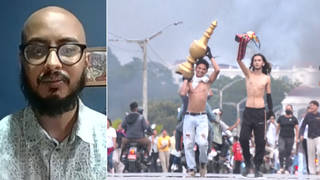
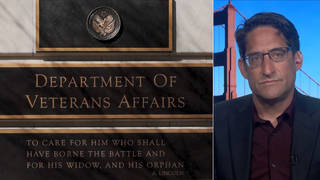
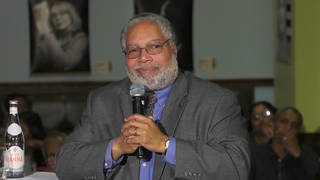
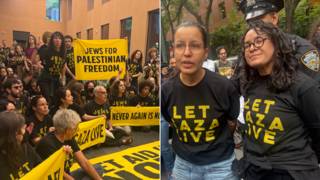
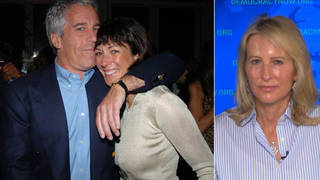

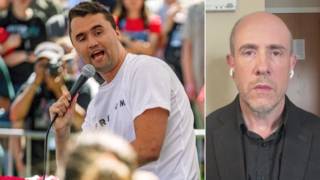
Media Options